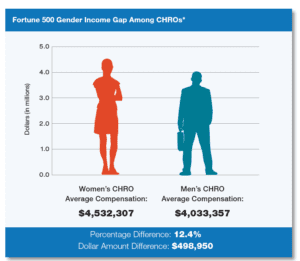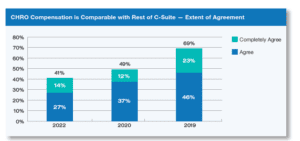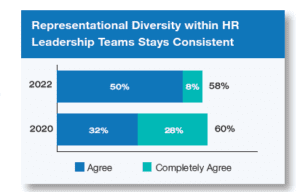Does CHRO compensation accurately reflect HR’s work and its impact on company performance?
By Zee Johnson
CHROs have always had an array of critical tasks, including leading successful talent acquisition (TA) and retention efforts, ensuring the proper training and development of staff, and creating strategies that support a continuous pipeline of quality talent, to name a few. And during the pandemic, this to-do list grew even longer with the addition of more urgent duties, like confidant and crisis manager. With extra responsibilities comes extra compensation, right?
HRO Today recently released our CHRO Compensation Study, a compilation of data on 175 senior HR executives across the Fortune 500 that sought to find correlations—if any—between salary, total cash compensation, and non-cash compensation. It also looked at possible connections between senior HR executive compensation, company performance metrics, company size, and more. This data, paired with our network of executives and survey results from 2020, produced key findings.
The Total Package
The research found that there were many variations of HR compensation packages, with smaller companies having no consistent correlation between company performance or size within CHRO compensation. Thus, factors like industry or location most notably affected senior HR executive wages.
Respondents were asked if they agree that larger organizations pay HR practitioners more than smaller organizations and 68% agreed, down from 83% in 2020.
However, Donna Szarwark, vice president of HR at Cincinnati Incorporated, believes that when it comes to compensation, the factors that matter most have nothing to do with company size.
“I believe complexity of the position plays a big role in compensation: is the company planning for mergers and acquisitions, legal concerns, labor issues, multiple locations to monitor federal, state, city and municipal laws, etc.?” she explains. “I would also say individual performance plays a role.” Szarwark’s thoughts supports survey findings that show that CHRO compensation is primarily driven by factors unrelated to company performance.
Director of People Operations at Blackthorn.io, Ryan-Mae McAvoy feels CHRO compensation reflects company culture and individual experience. “Companies that know that people are their most valuable resource pay their CHROs in line with the C-suite. In other spots, the CHRO may be comped lower if a person is looking more at title and ‘learning as they go,’” she says.
Agreeing that compensation is a great pathway to seeing how companies care for their employees, Gianna Driver, CHRO at Exabeam, says a proper package entails more than just base dollars. “At its core, a total compensation package consists of base pay, bonus pay (for employees with a variable pay component), and equity compensation,” she says. “Equitable compensation entails that similarly-qualified employees, regardless of gender, ethnicity, religious affiliation, or related differences, are paid equitably and per the company’s compensation bands and philosophy.”
To build a suitable package complete with the perks workers really wanted, Exabeam leaders used insights from employee surveys and an annual compensation and benefits review to place priority on the changes that needed to be made for comp to be more competitive. From this, some of the tangible and intangible benefits the organization began implementing include:
- enhanced medical benefits;
- mental and emotional well-being benefits;
- financial benefits;
- opportunities for career advancement;
- equal opportunities for recognition; and
- continuing education programs.
An ideal compensation package has unique benefits that Szarwark thinks should greatly supplement a solid monetary offering. “In addition to base salary you might also see bonuses, stock options, severance packages, SERP plans, and other perks such as club memberships, car allowance, tax services, and more,” she says.
In Comparison To…
When respondents were asked if they felt their CHRO should be compensated on par with other C-level executives within their company, 96% agreed that compensation among C-level executives should be comparable, up from 83% in 2019. But what respondents believe should occur versus what’s really happening appeared drastically different. Just 41% believed that CHROs at their companies were being compensated comparably to other C-suite executives, a 55% difference between “what-should” and “what-is.”
Tina Krebs, chief people officer at Relias, says that the pandemic helped to position CHROs as one of an organization’s most valuable leaders. Therefore, any salary discrepancies and misalignments must be handled swiftly. “The last several years should have helped align the CHRO compensation package with other senior leadership packages, as the CHRO skillset has been critical in navigating the pandemic, significant turnover, a new generation entering the workforce with different ideals, and the transition back to working in different models than prior to the pandemic,” she says. “If there is still a gap, I believe company leaders need to reevaluate if they are focusing on the right things – the CHRO is a critical role in most businesses right now.”
Szarwark says her company’s CHRO compensation is spot on, but notes that this isn’t standard at every organization. “I believe CHRO compensation is within the pay grade and range, however it is not uncommon to see HR as the lowest or second lowest paid in the C-suite.”
This is an observation that Driver has also made. “There are varying pay differentials for C-level roles. For example, a chief financial officer is often paid differently compared to a CHRO. But the last several years have really shown CEOs and boards the criticality of CHROs in organizational success,” she says. “While there continues to be pay variance for CHROs compared to other C-level executives, the pay gap has narrowed and market dynamics along with compensation data have helped CHROs become more equitably compensated relative to other C-level peers.”
Speaking of pay gaps, when asked about differences in pay as it pertained to race, 71% of respondents agreed that the level of compensation for minorities is comparable to non-minorities in their HR department, down from 77% in 2020.
And when asked if minorities in executive roles are compensated on par with other executives in their company, 70% agreed with the statement in 2022, down from 76% in 2020. When segmented, 80% of organizations with less than 500 people agreed that minorities in executive roles are compensated on par with other executives in their company. That percentage dropped by 15% to 65% for organizations with more than 500 people.
Driver has a possible solution to rectifying the minority pay gap—and it starts at hello. “The solution of pay equality begins at the recruitment phase of the employee life cycle,” she says. “Having structured compensation bands that are applied to all candidates regardless of ethnic origin will reduce disparities later. Additionally, performing regular compensation reviews irrespective of gender, race, or similar classifications will help ensure consistent and fair treatment throughout the employee life cycle.” If these reviews yield any disparities in compensation, she says, companies should address and rectify them immediately.
Szarwark thinks that having the proper technology in place is another way for leaders to identify and eliminate pay disparities. “I believe in educating those who make the decisions to utilize data. This includes your board, CEO, and management.”
But race isn’t the only demographic present in pay differentials—gender is, too. This appears to be changing, however.
The report revealed that the gender pay gap closed significantly, with women earning on average nearly $500,000 more than men. While women did have lower salaries in 2021, they saw higher total compensation, decreasing the pay gap by nearly 10%. And compared to 2020 data, CHRO salaries almost doubled.
McAvoy says working together has played a huge role in fixing the problem. “I genuinely think it is the male counterparts who are standing up and saying, ‘Hey this isn’t right.’ Males are using their voice to change the narrative,” she says, while also believing that the only way to close demographic-based gaps is by not considering those factors in the first place.
By design, HR works closely with compliance practices, EEOC, disparate treatment, pay rules and more. So, Driver says it was only a matter of time before equity prevailed. “Part of [HR’s] role is helping to ensure fair and equitable treatment for all employees, so it’s imperative we live by our own rules,” she says. “HR has usually been one of the most diverse parts of an organization and typically has had a high female-to-male ratio. We’ve been trailblazers in equitable gender pay.”
Doing Things Differently
When referencing their own organizations, 53% of respondents felt the most senior HR person in their organization was fairly compensated, a decrease from 62% in 2020. And it gets worse: Just 23% believed senior HR executives were compensated fairly across organizations, a stiff decline from 38% in 2019.
If this view isn’t remedied, it could prove to be detrimental to the evolution and growth of HR departments, leading to practitioners possibly losing the incentive to grow and perform.
But there are trends emerging that could help change this. “Some of the biggest trends are education and transparency into salary and bonus calculations,” Szarwark says. “I believe digital and mobile technologies [will] make it easier to give continuous updates in order to drive desired results and actions.”
Also acknowledging transparency as a growing trend, Krebs associates its emergence with the new generation of workers. “This new generation, as well as some younger Millennials, share compensation willingly and are requesting companies to share compensation information regularly; not just for equity reasons, but also to help them with their career pathing choices,” she says.
For Driver, a solid, fool-proof plan, regardless of work model or worker location, can make all the difference. “I anticipate more organizations will have a structured approach to handling compensation changes related to promotions and job mobility,” she says. “I also believe remote and hybrid work dynamics will continue, which means companies will need to clearly define their stance on geographic pay differentials, i.e., how much of a geo discount factor to apply when someone moves from a high-cost geography to a low-cost geography, or vice versa.”
While there are recurring themes and beliefs in each edition of the CHRO Compensation Study, each year also brings forth significant changes, including updated initiatives that address compensation structure and compensation gaps. But of all changes, ensuring packages are robust and fulfilling will generate higher CHRO satisfaction. “I think the trend is viewing the full offering, not just the cash piece,” McAvoy says. “Cash won’t solve all; you must have decent benefits/perks, time off, flexibility, and a culture people want to work in.”

















